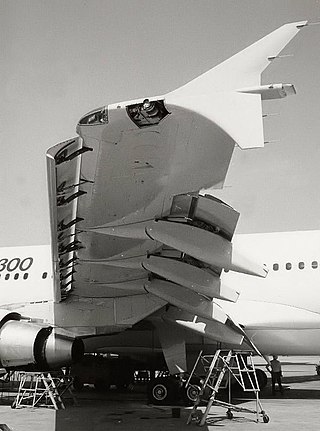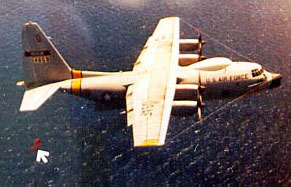
A helicopter rescue basket is a basket suspended below a helicopter in order to rescue people from a fire or other disaster site.

A helicopter rescue basket is a basket suspended below a helicopter in order to rescue people from a fire or other disaster site.


There are two main types of helicopter baskets. The smaller, more common type is used by rescuers to lift a person up from ground or water into the helicopter. An early type that could scoop an unconscious person from the sea was the Sproule Net, invented by Lt Cdr John Sproule, RN, in 1956 which was used by British helicopter rescue units until the late 1970s. [1]
The second type is a new invention. This is a basket able to fit five people or more. It allows a large group of people to be rescued from a fire or other emergency site, without needing to load them into the helicopter itself. It enables the helicopter to load a large group without landing. The helicopter hovers over the site and rests the basket on the ground or other surface. Evacuees board, then are transported to a safe area.

This type of basket was tested by the Air National Guard in 2006, and were found to be quite functional. Guard personnel tested out a basket which could fit up to 15 people, at the Air National Guard-Air Force Reserve Command Test Center at Tucson, Ariz. The basket which was tested is known as the Heli-Basket, is 4-and-a-half foot by 8-and-a-half feet, and hangs on a 125-foot cable below an HH-60G Pave Hawk helicopter. it was invented by John Tollenaere, of the company Precision Lift, Inc. [2]

The Boeing Vertol CH-46 Sea Knight is an American medium-lift tandem-rotor transport helicopter powered by twin turboshaft engines. It was designed by Vertol and manufactured by Boeing Vertol following Vertol's acquisition by Boeing.

The Boeing CH-47 Chinook is a tandem-rotor helicopter developed by American rotorcraft company Vertol and manufactured by Boeing Vertol. The Chinook is a heavy-lift helicopter that is among the heaviest lifting Western helicopters. Its name, Chinook, is from the Native American Chinook people of Oregon and Washington state.

A hovercraft, also known as an air-cushion vehicle or ACV, is an amphibious craft capable of travelling over land, water, mud, ice, and other surfaces.

Search and rescue (SAR) is the search for and provision of aid to people who are in distress or imminent danger. The general field of search and rescue includes many specialty sub-fields, typically determined by the type of terrain the search is conducted over. These include mountain rescue; ground search and rescue, including the use of search and rescue dogs ; urban search and rescue in cities; combat search and rescue on the battlefield and air-sea rescue over water.

The Sikorsky CH-53E Super Stallion is a heavy-lift helicopter operated by the United States military. As the Sikorsky S-80, it was developed from the CH-53 Sea Stallion, mainly by adding a third engine, adding a seventh blade to the main rotor, and canting the tail rotor 20°. It was built by Sikorsky Aircraft for the United States Marine Corps. The less common MH-53E Sea Dragon fills the United States Navy's need for long-range minesweeping or airborne mine countermeasures missions, and performs heavy-lift duties for the Navy. The Sikorsky CH-53K King Stallion, which has new engines, new composite rotor blades, and a wider aircraft cabin, is set to replace the CH-53E.

The Sikorsky H-19 Chickasaw is a multi-purpose helicopter that was used by the United States Army and United States Air Force. It was also license-built by Westland Aircraft as the Westland Whirlwind in the United Kingdom. United States Navy and United States Coast Guard models were designated HO4S, while those of the U.S. Marine Corps were designated HRS. In 1962, the U.S. Navy, U.S. Coast Guard and U.S. Marine Corps versions were all redesignated as H-19s like their U.S. Army and U.S. Air Force counterparts.

The CH-53 Sea Stallion is an American family of heavy-lift transport helicopters designed and built by the American manufacturer Sikorsky Aircraft.

A flap is a high-lift device used to reduce the stalling speed of an aircraft wing at a given weight. Flaps are usually mounted on the wing trailing edges of a fixed-wing aircraft. Flaps are used to reduce the take-off distance and the landing distance. Flaps also cause an increase in drag so they are retracted when not needed.

The AérospatialeSA 321 Super Frelon is a three-engined heavy transport helicopter produced by aerospace manufacturer Sud Aviation of France. It held the distinction of being the most powerful helicopter to be built in Europe at one point, as well as being the world's fastest helicopter.

The Mil Mi-6, given the article number izdeliye 50 and company designation V-6, is a Soviet/Russian heavy transport helicopter that was designed by the Mil design bureau. It was built in large numbers for both military and civil use and was the largest helicopter in production until the Mil Mi-26 was put in production in 1980.

William Hart Pitsenbarger was a United States Air Force Pararescueman who flew on almost 300 rescue missions during the Vietnam War to aid downed soldiers and pilots.

The Fulton surface-to-air recovery system (STARS) is a system used by the Central Intelligence Agency (CIA), United States Air Force, and United States Navy for retrieving individuals on the ground using aircraft such as the MC-130E Combat Talon I and B-17 Flying Fortress. It involves using an overall-type harness and a self-inflating balloon with an attached lift line. An MC-130E engages the line with its V-shaped yoke and the person is reeled on board. Red flags on the lift line guide the pilot during daylight recoveries; lights on the lift line are used for night recoveries. Recovery kits were designed for one- and two-man retrievals.

Rescue swimmer is a designation given to rescue specialists, most commonly in the service of the military. Rescue swimmers usually are charged with the rescue, assessment, and rendering of medical aid to persons in distress in the sea, on the land, or in the air. This highly specialized position is extremely challenging.

The Sikorsky CH-53K King Stallion is a heavy-lift cargo helicopter designed and produced by Sikorsky Aircraft. The King Stallion is an evolution of the long running CH-53 series of helicopters which have been in continuous service since 1966, and features three uprated 7,500 shp (5,590 kW) engines, new composite rotor blades, and a wider aircraft cabin than its predecessors. It is the largest and heaviest helicopter in the U.S. military.

Air-sea rescue, and aeronautical and maritime search and rescue (AMSAR) by the ICAO and IMO, is the coordinated search and rescue (SAR) of the survivors of emergency water landings as well as people who have survived the loss of their seagoing vessel. ASR can involve a wide variety of resources including seaplanes, helicopters, submarines, rescue boats and ships. Specialized equipment and techniques have been developed. Both military and civilian units can perform air-sea rescue. Its principles are laid out in the International Aeronautical and Maritime Search and Rescue Manual. The International Convention on Maritime Search and Rescue is the legal framework that applies to international air-sea rescue.

A litter is a stretcher designed to be used where there are physical obstacles that impair movement, including other hazards such as, in confined spaces, on slopes or uneven terrain, or in densely forested areas. Typically it is shaped to accommodate an adult in a face up position and it is used in search and rescue operations. The person is strapped into the basket, making safe evacuation possible. The person generally is further protected by a cervical collar and sometimes a long spine board, so as to immobilize the person and prevent further injury.

A helicopter is a type of rotorcraft in which lift and thrust are supplied by horizontally spinning rotors. This allows the helicopter to take off and land vertically, to hover, and to fly forward, backward and laterally. These attributes allow helicopters to be used in congested or isolated areas where fixed-wing aircraft and many forms of short take-off and landing (STOL) or short take-off and vertical landing (STOVL) aircraft cannot perform without a runway.

United States Coast Guard Air Station Houston is a United States Coast Guard Air Station located 15 miles (24 km) southeast of downtown Houston, Texas on board the Ellington Field Joint Reserve Base (JRB).
The 2006 New Zealand bravery awards were announced via a special honours list on 14 October 2006, and recognised 15 people for acts of bravery between 2000 and 2005.